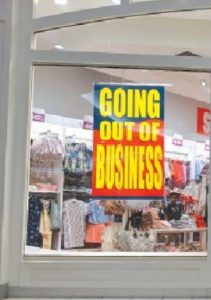 Thanks to online shopping gaining currency amongst the people across the globe, the retail sector, which emerged as the sunrise sector, recently, is going out of business. Top brands like Forever 21, Walgreens, Dressbarn, GameStop, Gap, and other chains have already announced over 8,500 store closings in 2019. This is way more than we saw during all of 2018.
Thanks to online shopping gaining currency amongst the people across the globe, the retail sector, which emerged as the sunrise sector, recently, is going out of business. Top brands like Forever 21, Walgreens, Dressbarn, GameStop, Gap, and other chains have already announced over 8,500 store closings in 2019. This is way more than we saw during all of 2018.
It is even more startling that Coresight Research has predicted that the stores that are closing down their number could hit 12,000 by the end of the year. The investment bank UBS says that another 75,000 stores could be lost by 2026. Retailers closed a record-breaking 102 million square feet of store space in 2017, then smashed that record in 2018 by closing another 155 million square feet of space, according to estimates by the commercial real estate firm CoStar Group. “This year we are predicting more of the same in the retail space”, said Dres Myers, a CoStar senior consultant.
Retailers have announced more than 4,300 store closures so far this year, according to an analysis by Business Insider. Big stores like GAP, JCPenney and Victoria’s secret announced more than 300 store closures over the course of 24 hours this week. Payless has said it plans to close all of its 2,500 stores in what could be the largest liquidation in history.
The whopping closure rate of stores that rocked the retail industry over the last couple of years has continued in 2019 with roughly the same level of closures in the previous years.
Payless filed for bankruptcy in February and said it planned to close all of its 2,500 stores in what could be the largest retail liquidation in history. Gymboree Group filed for Chapter 11 bankruptcy protection in January and said it planned to close more than 800 stores under its Gymboree and Crazy 8 banners. Gymboree previously filed for bankruptcy as recently as June 2017 and closed nearly 400 stores in the process.
Shopko filed for bankruptcy in January and has said that it would close 251 stores. Even popular and trendy Target finds itself with money-losing stores that it needs to shake loose.
The company said it would close a half-dozen by February, in what has become an annual event. The chain shuttered 13 in February 2018, and a dozen a year earlier. The British fast-fashion chain Topshop got a star-studded welcome when it invaded America in 2009, with celebrities including rapper Jay-Z and supermodel Kate Moss celebrating the opening of the first U.S. store in New York. Now, after just 10 years, Topshop has already made an exit. It wound down all 11 of its Topshop and Topman stores in the U.S., in cities that also include Chicago, Los Angeles, Houston, Miami, and San Diego.
The Gap said that it would close 230 namesake stores over the next two years as it reported that the brand’s same-store sales fell 7% during the holiday quarter. The company also said it would spin off its Old Navy brand. Performance Bicycle’s parent company, Advanced Sports Enterprises, filed for bankruptcy protection in November and later announced that it would close all 102 of its stores.
Charlotte Russe kicked off closing sales at 94 stores in February, after the company filed for Chapter 11 bankruptcy protection. Sears Holdings, which owns Sears and Kmart stores, emerged from bankruptcy in February after filing for Chapter 11 bankruptcy protection in October.
Destination Maternity plans to close between 42 and 67 stores this year. Victoria’s Secret said it would close 53 stores this year, citing a “decline in performance”. Christopher and Banks are closing 30-40 stores and JCPenney about 27 stores. It said it would close 27 stores in 2019, including 18 full-line department stores and 9 home and furniture stores. The department-store chain said same-store sales fell 4% during the fourth quarter. Henri Bendel closed all its stores in January after 123 years in business.
Beauty Brands, a regional chain of salon and spa superstores said it planned to close 25 stores this year. Lowe’s is closing 20 stores across 13 states this year. Macy’s is closing stores in Wyoming, Washington, California, New York, Indiana, Massachusetts, Virginia, and West Virginia. J.Crew is closing stores in Georgia, South Carolina, Tennessee, Louisiana, California, and Canada.
Kohl’s is closing four stores this year. All the closing stores are located near a shopping mall. Nordstrom is closing stores in Florida, Virginia, and Rhode Island.
Shuttering stores or declaring bankruptcy in recent months amidst sagging sales is a pointer to the fact rise of e-commerce outlets has made it harder for traditional retailers to attract customers to their stores. The brick and mortar locations are out of fashion and giving way to digital efforts.
Indian scenario
From just $3.5 billion in 2014, the e-commerce retail is expected to reach $100 billion in 2020 in India! In the year 2009, the Indian e-commerce industry achieved approximately $3.8 billion in revenue and in next three years by 2012 the number went up by almost three times to $9.5 billion. For next three years while predictions estimated a growth of 33%, the industry managed to surpass even that, to achieve $12.6 billion by 2015. The analysts have made projections suggesting an overall market value of organized retail in India to be $1 trillion by 2020.
However the Shakespearean “to be or not to be that is the question”, these numbers now seem unlikely. Reason, the e-commerce continues to evolve. This has started affecting India’s traditional retail industry referred to as the brick-and-mortar retail. The retail sector is experiencing a great deal of churn as physical retailers take new and elaborate measures to keep up with their online competitors. First the retail stores felt heat from big malls and now the e-commerce.
Millennial generation moved to online shopping. India’s first brush with e-commerce was in the year 2002 when the government of India launched a website for online railway ticket booking via IRCTC. This was especially directed for the common man who then didn’t have to stand in long queues, waste time and reduced the burden on the ticket bookers overall. Although retail sales were available online since the year 2000 with Rediff shopping and even eBay, online shopping was, in effect, re-launched in India when Flipkart, a company founded by two Chandigarh based technocrats, offered very high discounts on their website. Since then, a great number of other merchants like Amazon have jumped onto the online bandwagon. The e-commerce sector in India is currently growing at a furious pace of 34% since last one decade.
The young internet-savvy population of India, is one of the biggest driving forces of e-commerce in the country. The young populace is driving e-commerce sales up, and the new and improved mobile apps make it convenient for shoppers to make purchases on the go.
Consumers in tier-2 and tier-3 cities, who may not have access to top brands, fulfill their desires by going the online way. The user-friendly interfaces, multiple online stores, trending fashion, easy and very secure online payment methods and discounts round the year make online shopping attractive. Naturally, the frenzy of online buying has severely hit the offline retailers. The offline retailers have approached the government to intervene in their price war with the online merchants.
The inherent attitude of ‘touching and feeling’ the products before buying for the Indian consumers. In a twist of tale, MakeMyTrip has physical outlets in more than 40 cities in India and operates through 63 such outlets; so does BharatMatrimony and now, Yatra.com plans to open 100 new physical stores. Why? It is to cater to the millions who have yet to purchase online? Although there are over 200 million internet users in India, only 32 million are the actual shoppers. The Indian sceptical mind-set still yearns for that ‘physical touch’ of products like those for the baby or expensive items like jewellery or watches. Keeping this in mind exactly, merchants like Caratlane.com and firstcry.com have set up physical shops for customers to try out their items.
The innovative retail stores are providing a mix. Many big players are boosting their overall revenues by their digital e-commerce sales to their preexisting traditional retail systems. There is a reason why Snapdeal and Croma are now partners or Amazon and Big Bazaar are not just retailers. It is a partnership of technology meeting logistic service offerings. Shoppers Stop has revamped their online platform and so is Reliance to attract the online consumers.
With the digital age, there is definite a paradigm shift leaning more towards e-commerce. The brick and mortar retailers must comply and adjust themselves to new strategies like the business mix-having retail presence and going online or merging with established online businesses to survive.
“It is not the strongest or the most intelligent who will survive, but those who can best manage change.” The statement coming from great scientist, Charles Darwin in the 19th century for the theory of evolution, is perhaps most relevant to Indian retail industry in the 21st century.
letters@tehelka.com













